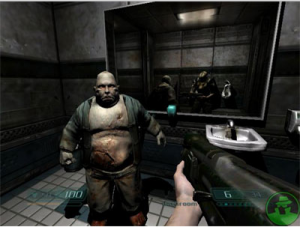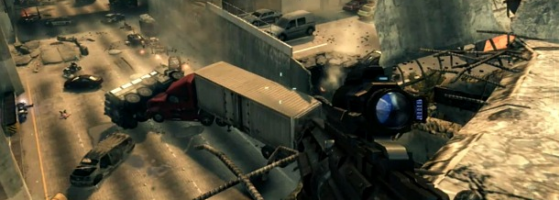A few weeks ago, game designer Adrian Chmielarz who was a co-owner of the studio People Can Fly, wrote a piece on Gamasutra regarding the disconnect between visuals and game design these days.
Essentially how video game art and audio have grown beyond the scope of game design. Giving us cases where games look and sound realistic, but fall back on gamey tropes. This in turn pulls the gamer out of the experience and in a way makes the game generic. This kind of disconnect has become apparent in AAA game development. For this series I want to take a look at some of the major ones I’ve noticed after spending over twenty years playing games.
The Bullet/Sword/Fire/etc Sponge:
Health in video games has always been an abstract concept: from hearts, a bar, numbers and even just the screen flashing red. Each method was designed to give the player an idea of how much damage they could sustain before dying.
However for having so many different representations, health has never been realistic. Would anyone care to explain to me how a first aid kit in Doom could repair bite marks, rocket launcher damage or shotgun blasts? Or how in Bioshock Infinite, food from trash cans could repair damage?
Since the early days, we have brushed off defining health in a realistic form as games were never realistic to begin with. Some games went the extra step and required the player to use a secondary item to heal major damage or aliments.
Metal Gear Solid 3 for instance had a full medic system that required the player to eat food to keep their hunger down and regenerate health on its own. Along with treating major injuries with various medical items to restore the player’s maximum health.
Ironically, fantasy games, which were the most unrealistic had the most rational explanation for healing: magic potions. Sure, no one knew how drinking a red potion would heal you, but it still made more sense then what we’ve seen in other games.
When looking at table-top or pen and paper games, designers explained health as an abstract sum of the person’s well being. So that being cut by a sword meant that the person had a nasty cut that was bleeding out, or a fireball caused severe burn damage. And the act of “healing” was performing any tasks related to curing said damage.
Since the last decade as video game graphics have expanded to be near photo-realisistic, the health system has stood out all the more from the experience. Care to explain how soldiers in Call of Duty recover from gun-shot wounds by hiding for 10 seconds?

Even as the technology improved, the Doom series was never about realistic health or combat but was fun nonetheless.
An even gamier concept is the act of health upgrades. Now we have characters who after enough experience or finds enough items, can withstand bullets even more.
At least games in a Sci-Fi setting can waive it off with techno-babble or nano-machines.
Some games try to work around this by featuring both static and auto regenerative health systems: To base the system around the character shrugging off basic damage, but needing to recover from more pressing damage. The Chronicles of Riddick was an example , but we don’t see too many games go this option and instead choose one or the other.
But while talking about the player is pretty gamey, we can’t ignore the enemies. Video game logic dictates that the higher up you are in an evil organization, the more resistant to damage you apparently become.
This becomes unintentinally funny when you fight boss enemies who are human and can somehow resist bullets to the face. Some games try to explain this as the character was wearing body armor or was strong, but once again a bullet to the face is a bullet to the face.
Of the five we’re going to talk about, health is the one that stands out as the hardest element to move a way from. So much of a game’s balance and design relies on the health system in place. That to try something experimental would require a radical change in design.
A few years ago I came up with the concept for a different kind of health system for a horror game. Where instead of the player shrugging off major damage, they would instead automatically dodge fatal attacks costing them stamina. If the player ran out of stamina the next fatal attack would connect.
Now, reading that last paragraph the system sounds just like a traditional health meter. However the difference was that health system was grounded more in reality. It may not sound like a big deal, but little touches like that could reduce the gameyness of a health system.
But as we’re going to talk about over the next four days, it’s not just one issue that needs to be looked at, but several.
Up Next: One Man (Vs.) Army



Pingback: 5 Realistic Fallacies in Game Design: Enemies | Game Wisdom()
Pingback: 解析游戏设计的5大现实谬论之生命值 | GamerBoom.com 游戏邦()
Pingback: 解析游戏设计的5大现实谬论之生命值 - 爪游控()